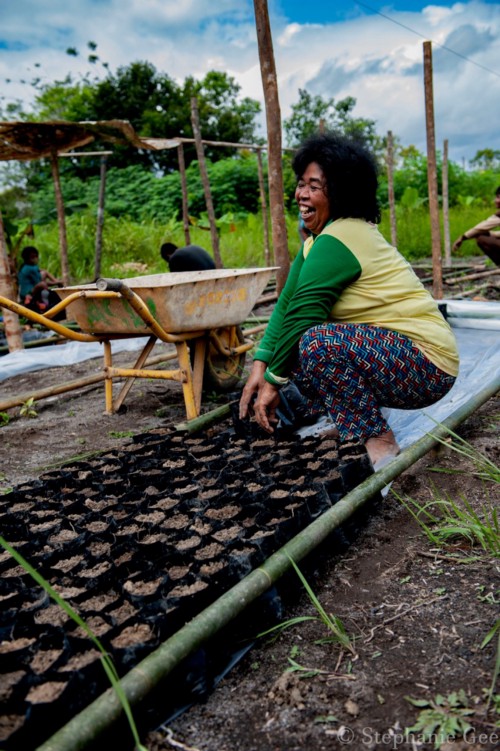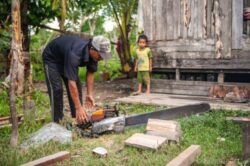With the immense capacity to sequester carbon, preserving the earth’s rainforests is critical to meeting our collective emissions reduction goal. The organization Health In Harmony collaborates with forest dwellers in Madagascar and Indonesia to safeguard rainforests by providing needs determined by communities themselves. So far these have included healthcare and training in organic farming methods. Health In Harmony’s Radical Listening process fosters a just transition — from logging to sustainable livelihoods — by paying attention to people’s needs, constraints, and place-based ties. This method is also at the heart of our Behavior-Centered Design approach at Rare’s Center for Behavior & the Environment.
Erik Thulin, Behavioral Science Lead at the BE.Center, joined the founder of Health in Harmony, Dr. Kinari Webb, in conversation.
Rare: Too often, interventions in the development sector are designed by policymakers and scientists, far from the places and people they will impact. Your organization, Health in Harmony, inverts this by asking vulnerable communities what they need, a process called ‘radical listening’ that remains core to your mission — a just transition to sustainable livelihoods. How did you develop this methodology?
Kinari Webb: Two experiences helped me realize the critical importance of listening to communities and seeing the intersectional nature of problems. The first experience was during a year I spent in Borneo studying orangutans as an undergraduate. The forest was being logged around me, and my first impulse was to blame the loggers. However, in talking with many of them I discovered that they were often logging to pay for healthcare. While I had never thought of healthcare and logging as interrelated, as soon as the communities told me this, the relationship became obvious.
The second experience was in 2006 shortly after the tsunami off the coast of Sumatra where I spent two months doing medical relief work. Enormous amounts of aid were spent but much of the resources were simply wasted (like malaria medication in a region with no malaria). However, when communities asked for help clearing their rice fields of debris, the NGO community said that they were unwilling to do that but would continue to give rice.
It became clear to me that without listening to communities, we would waste resources as well as not achieve our desired outcomes. Over time we found that truly listening to communities was not only wildly effective but also leads to excitement, motivation, and agency.
Erik Thulin: The insight Kinari and Health In Harmony arrived at so intuitively, that sufficient contextual understanding and dialogue is critical for program success, is something that the behavioral science community is only just beginning to give the attention it deserves. This has important consequences for what is known as generalizability: the extent to which an intervention in one context can be transported to another.
Researchers in public-health and anti-poverty programs have started to develop a framework for thinking about this puzzle of how we can know what is relevant from what has worked in one context in order to understand what might work in another. The key insight from this research is that we must focus not on the specific implementation, but on the underlying mechanism. If we know why a program works in one context, ideally all the way down to its specific psychological effect, we can harness local knowledge of the target context to predict the degree to which the program will apply in that new context as well.
As an organization, Rare has been focusing on developing tools similar to Radical Listening that allow us to identify those relevant contextual factors, with the north star of merging the insights gleaned from local understanding with generalizable psychological insights to improve programming across the environmental space.
Rare: Using cash transfers as incentives for locals to engage in environment-friendly behaviors, or “payment for ecosystem services,” is common practice in conservation. Your approach has been different. Instead of offering money, Health in Harmony provides services that help individuals permanently quit illegal logging in the rainforest. Since you began working in central Borneo’s Gunung Palung National Park 13 years ago, there has been a 90% decrease in logging, a 67% decrease in infant mortality and 52,000 acres of secondary forest regeneration. Why do you think this model has been so successful for humans and the environment?

KW: My experience is that what communities often need is not cash but rather things that money can’t buy locally because they simply don’t have access to them. Around Gunung Palung National Park (our first site) communities asked for two things as a ‘thank you’ from the world community for protecting the park: high-quality, accessible healthcare and training in organic farming. Neither one of those things would have been purchasable with cash transfers. Each required connections beyond their communities, the capacity to negotiate and coordinate with the government, and capacity building in skills that were simply not available locally. We have found this everywhere we have done radical listening: communities need things that aren’t easily purchasable locally or would be so prohibitively expensive that cash transfers likely couldn’t cover them.
ET: Whether or not it was intended, I think one of the biggest lessons from the payment for ecosystem services model was that efficiency of cash in hand is king. This economic model is too simplistic in that it does not capture what each stakeholder brings to the table. A more holistic model would recognize that the value of external organizations in a community often extends beyond the cash incentives they can potentially offer, including access to other, more relevant resources for the community.
What is perhaps most surprising here is that this is exactly the outcome that an economist would have suggested in the first place: cash is only king when all parties have the same access to resources that can be purchased with money. Instead, through their Radical Listening approach, Health In Harmony recognized that their organization was in a position to deliver unique value to communities through providing access to non-monetary intangibles — healthcare, training — creating a positive-sum outcome for both the organization and their partner communities.

Rare: In an interview with Public Radio International, you describe how radical listening sessions begin with the question, “What would you need as a thank you from the world community so that you could protect this precious forest that you are all guardians of?” Why did you choose to frame Health in Harmony’s work in this way?
KW: Your team at Rare is actually the one who helped me understand what we were doing from a philosophical perspective. I knew I was very averse to simply turning the relationship into a monetary transaction such as with carbon credits but you helped remind me why that is. People are much more likely to do something when it comes from intrinsic motivation rather than extrinsic. Every rainforest community our team has known (across Indonesia, the Philippines, Madagascar, and Brazil) loves their forest. They very much want to protect it; they just aren’t capable of doing so. What we also have found is that no one wants to be the recipient of charity. When we have framed the question in this way, people sit up straighter in their chairs.
One man explicitly told me, “I love that you asked the question that way, because it is true — we have something precious to give the world and we could really use some help to actually protect it.” By framing it as a ‘thank you,’ both donors and rainforest communities can feel proud of what they are giving to the world.
Stanford University also recently did an external assessment of our first site. They compared the forest loss at Gunung Palung to other national parks in Indonesia and found that the estimated carbon value of the averted forest loss was $53,000,000 over the first ten years of the program. During this time the world community gave $3,000,000 in thanks — in the form of healthcare and training in organic farming — to these rainforest communities. With the framing of reciprocity, everyone can be delighted in these numbers and proud of them. However, if the transaction had been framed as simply paying for ecosystem services, communities might have felt they deserved more money or could have earned more through logging. Monetizing what can’t be monetized (biodiversity, sense of place, feeling that the forest is your mother, long-term climate mitigation, etc.) can be inherently dangerous.
ET: I am again struck by how Health In Harmony intuitively arrived at some of the key insights of behavioral science on pro-social exchange. The first thing that sticks out to me with the focus on “thanking” is how it naturally frames the interaction in terms of reciprocity rather than a market exchange.
Over the last few decades, researchers have found that simply re-framing an interaction as being in a market context or not radically affects the degree to which people are willing to cooperate with each other. If you set up an interaction as financial, people look for how they can extract the most value. If you instead frame an interaction around community and reciprocity, people choose to uphold their side of a deal even without monitoring or enforcement.
Another key behavioral insight that Health In Harmony addresses here is that by making interactions in-kind rather than financial, they avoid what is known as motivational crowding. The research here shows that people’s social and intrinsic motivation to act pro-socially can be crowded out by material, and particularly financial, incentives. This is because of how these incentives affect individuals’ internal and social narratives about their behavior: it is hard to tell yourself, and others, that the pro-social thing you did was due to your intrinsic motivation when you were paid to do it. Instead, more effective interventions side-step this issue not by avoiding incentives, but by finding those incentives that narratively align with the target behavior. Health In Harmony’s example of offering training in organic farming illustrates this overlap perfectly.
There is a clear narrative that a former logger in Gunung Palung National Park can tell herself here: the reason I farm organic and the reason I preserve the forest is because I care about this environment. Being able to include that “and” in your story, where the incentive and the outcome behavior are motivationally aligned, is key.

Rare: As you scale this reciprocity-based, conservation-development approach to other parts of the world, what opportunities do you anticipate?
KW: I keep expecting to find places where people don’t want to protect their local ecosystems, but we have yet to see that. So far, all we find are places where people want to protect rainforests and are unable to do so because they are missing critical resources or knowledge. We believe this is an opportunity for mutual benefit for rainforest communities and global citizens. By listening to rainforest communities describe critical fulcrums of change and framing the relationship as a gift of reciprocity on both sides, there is great potential for multiplicative, positive effects.
ET: I’m excited to see Health In Harmony’s approach moving to larger scales. At Rare’s BE.Center we have a multi-step design approach for developing behaviorally-informed interventions called Behavior-Centered Design (BCD), and I am struck by how clearly Health In Harmony is already implementing many of the key steps we recommend. In our Empathize step, we ask changemakers to really take the time to understand the community with which they are partnering, including their goals and motivations. Health In Harmony is clearly first in class in that regard. Later in the BCD process, results of the Empathize step are paired with behavioral insights in order to Ideate behaviorally-informed solutions. Health In Harmony has already incorporated multiple behavioral insights into their ideation process, including the use of behaviorally-informed incentives and relying on the social influence of reciprocity. As Health In Harmony grows, it will be exciting to see the expansion of their toolkit to include even more levers for behavior change, further building on an already impressive success story.
Rare: Thank you for sharing your story with us. Any final thoughts?
KW: At our first site in Borneo, communities say that they are the pathfinders for where the world needs to go so that humans can thrive while living in balance with the earth. And they are right. They are the pathfinders and I, for one, want to follow them.
Stay updated on Rare’s Center for Behavior & the Environment news by becoming a member on behavior.rare.org and subscribing to our newsletter.